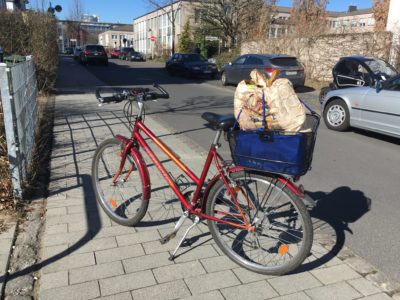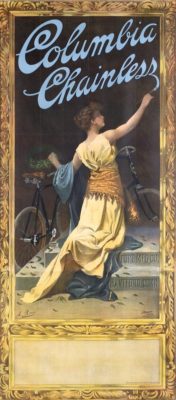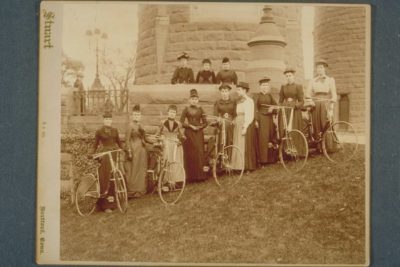How I learned to love the bicycle: Reflections on Pope and Twain from a nutmegger abroad
18 March 2019 – Rebecca Furer
memory, sense of place, international, consultants, gender/sexuality, 2019 annual meeting, Hartford series 2019

Pegasus bike with groceries, 2019. Image credit: Rebecca Furer
Editor’s note: This is the second in a series of pieces focused on Hartford and its regional identity which will be posted before and during the NCPH Annual Meeting in Hartford, Connecticut in March.
My bicycle rattles and bounces over the cobblestones in my neighborhood, and I take a quick glance behind me to make sure none of the groceries have fallen out of the basket. I think about Mark Twain. And Albert Pope. And Hartford.
I am a displaced Nutmegger. After twenty years of living and working in Connecticut, I have relocated temporarily with my family to Germany, taking advantage of a great work opportunity for my husband. This is why I shop for groceries by bicycle. To be fair, plenty of people in our city have cars. But we have opted for a combination of public transportation and bicycles, a distinct change from our former car-dependent lifestyle in the suburbs of Hartford.
On beautiful spring-like days like those we are having now, it is glorious to ride out in search of something for dinner or just an hour of peaceful exercise. Then there are the excruciating winter mornings—the sun not even up yet and freezing rain pelting down as we leave for school. Or an unexpected flat tire. Or the bungee cords you don’t notice you’ve forgotten until you have two huge bags of groceries that need strapping down. But I digress. Back to Twain, and Pope, and Hartford.
Albert Pope was a Civil War veteran who ran a business producing shoe-making tools in the Boston area. In 1876 Pope attended the Centennial Exposition in Philadelphia, where he saw his first bicycle. Pope was fascinated by the new vehicle—known at the time as a “velocipede.” In 1877 Pope ordered a batch of British-made velocipedes for sale in the United States, but his real dream was to produce bicycles himself. At the time, Hartford was already known as a center for innovation and precision manufacturing—the home of Colt Manufacturing Company, a pioneer in mass production and the use of interchangeable parts. In 1878 Pope hired the Weed Sewing Machine Company on Capitol Avenue in Hartford to build fifty high-wheel bicycles, which he marketed under the name “Columbia.” Eventually, Pope purchased the Weed Sewing Machine Company and converted the entire factory to bicycle production.

Advertisement for the Columbia Chainless Bicycle, 1897. Image credit: Connecticut Historical Society
The high-wheel bicycles that Pope produced at first were popular, but they had some significant drawbacks. They were expensive—both to make and to buy—and they were difficult to ride. Bumpy, unpaved roads added to the danger and discomfort of riding, and these early bicycles were sometimes nick-named “bone-shakers” (a term I have much more appreciation for now than I ever did back when most of my bicycle-riding consisted of leisurely outings on the smooth pavement of the beautiful Farmington River Trail!). Hartford resident Mark Twain, who bought a Columbia bicycle in 1886, wrote about his experience learning to ride on the streets of his West End neighborhood in the essay “Taming the Bicycle.” I encourage you to read the whole account for yourself—it is really enjoyable. Suffice it to say, Twain’s cycling education involved one repeatedly-flattened teacher, a wagon full of cabbages, and a fierce battle against the laws of physics.
Women didn’t really start cycling in numbers until the introduction of the “safety bicycle” in the mid-1880s. Lighter, easier to pedal, and with an improved braking system, safety bicycles had two wheels the same size, making them easier to both mount and dismount without mishap. By 1890, Pope had stopped producing high-wheelers, and within five years he had moved the headquarters of his company to Hartford. Pope Manufacturing became the city’s largest employer with 4,000 workers, and they produced 600 bicycles every day. With business booming, Pope donated land near the factory to the city for a public park, which still bears his name.
The surge in bicycle production in the 1890s wasn’t just good for industrialists and factory workers. Susan B. Anthony once declared, “Let me tell you what I think of bicycling . . . I think it has done more to emancipate women than anything else in the world. I stand and rejoice every time I see a woman ride by on a wheel. It gives women a feeling of freedom and self-reliance. It makes her feel as if she were independent.” Cycling opened up a new world to American women. Bicycle-riding was also recommended as healthful exercise, but it was difficult in tight corsets and floor-length skirts. While the loose-fitting trousers promoted by Amelia Bloomer had once been criticized as indecent, the bicycle’s new popularity brought divided skirts, Turkish trousers, and bloomers into more mainstream fashion. By 1896, about one-third of all bicyclists were women, and the bicycle craze quickly became intertwined with the struggle for women’s rights.

Ladies Cycle Club of Hartford, 1890. Photograph by Charles T. Stuart. Image credit: Connecticut Historical Society
I sometimes think of the women in an 1890 photograph of the Ladies Cycle Club of Hartford, taken in front of the Soldiers and Sailors Arch in Bushnell Park. Each woman in her fitted bodice or shirtwaist, every one of them wearing a jaunty hat. I think about my own hair squashed under my helmet and glance down at my worn sneakers and fleece jacket. I feel the almost-warm breeze on my face and consider where I might ride to the next time I have a few spare hours on a sunny day. Then I have to focus on the cars zooming by on my left and the package of toilet paper teetering precariously on the top of the pile in my basket. And I consider Mark Twain’s ultimate recommendation on the subject: “Get a bicycle. You will not regret it, if you live.” Genau, Mr. Twain. Exactly.
~Rebecca Furer is a consultant to museums and cultural organizations and former director of education and interpretation at the Connecticut Historical Society. She rides a used Pegasus bike and lives in Bonn, Germany.



